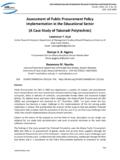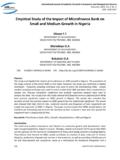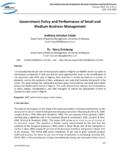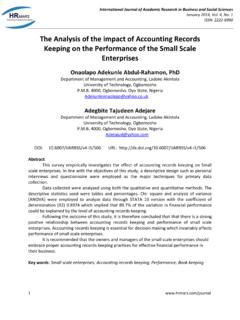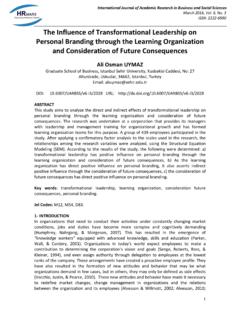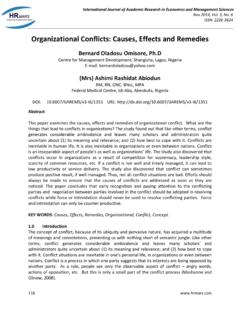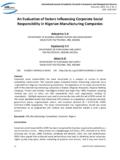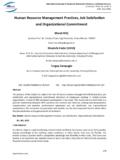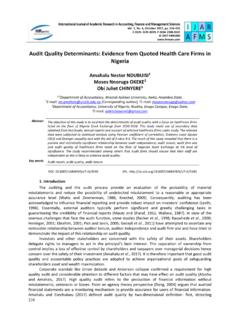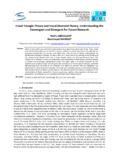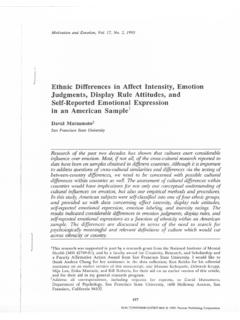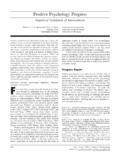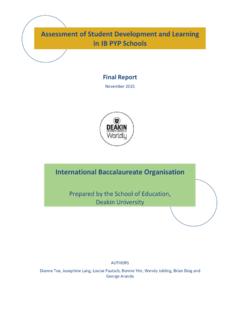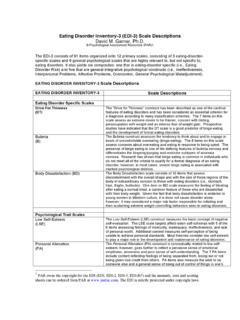Transcription of The Relationship between School Culture and Professional ...
1 International Journal of Academic Research in Business and Social Sciences 2016, Vol. 6, No. 12. ISSN: 2222-6990. The Relationship between School Culture and Professional Learning Community in Malaysia Mohd Faiz Mohd Yaakob Sultan Idris Education University, Malaysia Jamal@Nordin Yunus Associate Professor, Sultan Idris Education University, Malaysia DOI: URL: ABSTRACT. School Culture creates a psychosocial environment that profoundly impacts teachers, administrators, students and shapes its organization. Besides, the School considered as learning community and should practice the Professional Learning Community (PLC). This descriptive correlational study examined the Relationship between School Culture and PLC.
2 This study found that the School Culture and PLC have moderate positive Relationship (r= ). This research also provides ideas for future research by practitioners in this field. Keyword: School Culture , Professional Learning Community, Educational Management, Educational Planning. INTRODUCTION. School Culture is a pervasive element of schools. It permeates everything within a School : the way people act, how they dress, what they talk about or avoid talking about, whether or not they seek out colleagues for help, how teachers feel about their work and their students, and how students feel about the School (Deal & Peterson, 1999). An examination of School Culture is important because each School has a Culture of its own, and understanding these features is helpful in making it a better School (Goodlad, 1984).
3 School Culture can be regarded as a bridge or barrier to change. As Peterson and Deal (1998). pointed out, understanding School Culture is an essential factor in any reform initiative. It is part of the School change and innovation process (Dalin et al., 1993). A positive School Culture is often considered as one in which meaningful staff development and enhanced student learning are encouraged and practised (Engels et al. 2008) Furthermore, several studies confirm that School Culture plays an important role in enhancing School effectiveness (Heck and Marcoulides, 1996; Maslowski, 2001; Sammons et al., 1995). In other word, School Culture is closely related to the healthy and sustainable development of a School , the development and well-being of the School members, and the teaching and learning objectives (Fullan, 2001).
4 Meanwhile, Hoy and Miskel (2013) defined Culture as a distinct element that affects the behavior of the School and its interaction . 231. International Journal of Academic Research in Business and Social Sciences 2016, Vol. 6, No. 12. ISSN: 2222-6990. Meanwhile, schools with positive Culture present some characteristics such as an attractive classroom climate, teachers who are committed to teaching, student involvement in teaching and learning activities, the prevalence of order and discipline, existence of good Relationship between School staff and students, effective management, and teamwork in the School and classroom. Consequently, the necessary infrastructure and facilities are in place and are neat and safe for teaching and learning.
5 Lastly, principals and teachers maintain high Professional standards (Rampa, 2004). Developing schools as Professional learning communities (PLCs) is being strongly advocated by education reformers and researchers as a systematic and effective way to improve teacher quality. Teachers' qualities, such as teachers' self-efficacy and collective efficacy as well as their commitment to students, have been shown to affect students' achievements (Bandura, 1997;. Goddard, Hoy, & Hoy, 2004; Park, 2005; Thompson, 2004). In the restructuring of schools, the emphasis on Professional community is important in teachers' Professional development (Louis, Marks, & Kruse, 1996).
6 Louis et al. (1996) described shared values, a focus on student learning, collaboration, deprivatized practice, and reflective dialogue as five elements of Professional communities which could be considered as important components in the restructuring of schools. The concept of Professional learning community (PLC), a concept associated with Professional development, is also being used by many researchers. Hord (1997) proposed five dimensions of PLC which included supportive and shared leadership, shared values and vision, collective learning and application, supportive conditions, and shared personal practice. Although there is no universal definition of a PLC, a consensus view drawn from educational researchers and administrators is that a PLC exists in a School when a group of teachers collaboratively and critically exchange their instructional practices in an on going, reflective, inclusive, learning-oriented and growth promoting way to support innovation and knowledge sharing.
7 This study will investigate about the Relationship between School Culture and PLC among teachers in Malaysia. The PLC's programme in Malaysia is under the Continuing Professional Development (CPD) national blueprint. There is interest to study this Relationship to ensure that the School Culture and the PLC will improve the performance and quality of education in Malaysia. METHODOLOGY. A quantitative approach and survey research design was chosen for this study because the intent is to ask narrow objective questions generating quantifiable data that can be analyzed using statistics(Creswell, 2008).This study was a descriptive-correlational study.
8 232. International Journal of Academic Research in Business and Social Sciences 2016, Vol. 6, No. 12. ISSN: 2222-6990. Population and Sample The target respondents are among all the primary School teacher in Malaysia. The samples were selected using the multistage cluster sampling techniques. The study involved 612 primary School teachers from five zone areas of Malaysia represented by the states of Kedah, Selangor, Johor, Terengganu and Sarawak. This sample saiz achieve the minimum sample saiz according to Krejcie & Morgan (Krejcie & Morgan, 1970). There is 112 ( ) from Kedah, 163 ( ). from Selangor, 114 ( ) from Terengganu, 101 ( ) from Johor and 122 ( ) from Sarawak.
9 The total sample saiz as showed in Table 1. Table 1: Population and Sample Zone State (N) %. North Kedah 112 Centre Selangor 163 East Terengganu 114 South Johor 101 Borneo Sarawak 122 Total 612. Instrument The questionnaire is used as a primary survey instrument in collecting quantitative data in numerical form. The structure of the questionnaire was developed based on School Culture Elements Questionnaire (Cavanagh, 1997) and Professional Learning Community Questionnaire (Huffman, J. B. and Hipp, 2003). Reliability Reliability will assess through Cronbach alpha with threshold and above (Nunnally, 1978). calculated using SPSS. The result of reliability is and Table 1.
10 Result of Reliability Variables Cronbach Alha School Culture Professional Learning Community 233. International Journal of Academic Research in Business and Social Sciences 2016, Vol. 6, No. 12. ISSN: 2222-6990. FINDING. The significant Pearson correlations apparent in this study were between School Culture and PLC (r = .428, p < .000). The result showed there is moderate positive Relationship between School Culture and PLC among primary School teachers in Malaysia. Table 2. Result of Correlation Correlation School Culture Professional Learning Community Pearson 1 .428**. Correlation BS. Sig. (2-tailed) .000. N 612 612. Pearson .428** 1.
